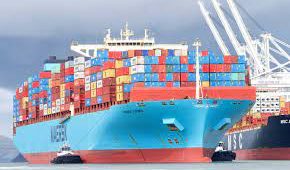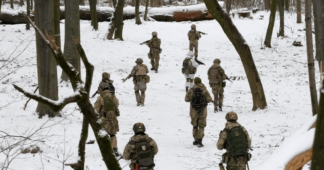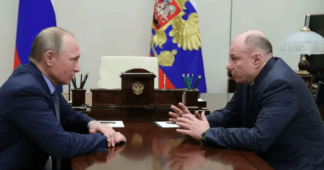By Marco D’Eramo
19 July 2022
Whoever the victor may be, it’s become increasingly unclear what winning the war in Ukraine would mean. The greater the destruction, the more intractable the conflict appears. With a rising death toll and escalating sanctions, the objectives of the belligerents seem ever more inscrutable. What would Russia gain from annexing an obliterated corner of Ukraine, compared to everything it would lose? Why would Ukraine run itself into the ground to retain a region which does not want to be detached from Russia? And to what ends would NATO erect a new Iron Curtain, thereby consolidating a Russian-Chinese bloc endowed with both raw materials and advanced technology?
Granted, for some time now the United States and its allies have fought wars in which victory is impossible to envision. What would winning have looked like in Iraq? If it involved turning the country into a Muslim replica of Israel, this was never a realistic outcome. In the end, it was practically handed over to the Iranian sphere of influence, while Afghanistan was abandoned to Pakistan and China. (All this without even mentioning the Syrian civil war.) Yet, if it is difficult to identify a potential victor in Ukraine, it is easier to pinpoint the potential losers. As we shall see, one of these will likely be what the Australian economist Joseph Halevi has termed the ‘German bloc’: a set of economically interconnected nations stretching from Switzerland to Hungary.
Of course, more or less all of us are losing out in the present conjuncture. When the invasion began, everyone was primarily concerned with the supply of gas and petrol. It was only later brought to public attention that Russia and Ukraine account for 14% of the world’s grain production and up to 29% of global grain exports. It was subsequently revealed that they provide 17% of corn exports and 14% of barley. As the treasure hunt continued, analysts realized that 76% of the world’s sunflower products come from the two states. Russia also dominates the fertiliser market, with a global share of more than 50%, which explains why the blockade has caused agricultural problems as far afield as Brazil.
More surprises were in store. The war hit not just the oil and gas sectors, but nickel too. Russia – home to Nornickel, a giant in the sector – produced 195,000 tonnes of nickel in 2021, or 7.2% of global production. The invasion, combined with increased demand for nickel used in power lines and electric vehicles, caused prices to skyrocket. Meanwhile the global superconductor industry, which produces calculators and computer chips, was heavily affected. The Russian steel industry sends neon gas to Ukraine, where it is purified for use in lithographic processes such as the inscription of microcircuits on silicon plates. The most important centres of production are Odessa and Mariupol (hence the relentless struggle over these areas). Ukraine provides 70% of the world’s neon gas, as well as 40% of its krypton and 30% of its xenon; its major clients include South Korea, China, the US and Germany. The supply of several other ‘critical’ metals is also endangered, as the Columbia Center for Global Energy Policy reported in April:
“Other metals of interest in the Russia crisis include titanium, scandium, and palladium. Titanium is strategic for aerospace and defense applications and Russia is the world’s third-largest producer of titanium sponge, the specific application that is critical for titanium metal. Used extensively in aerospace and defense sectors, Scandium is another key metal for which Russia is one of the three largest global producers. Palladium is one of the most notable critical minerals affected by the Ukraine crisis because it is a critical input to the automotive and semiconductor industries and Russia supplies nearly 37 percent of global production. Russian palladium illustrates one of the key geopolitical features of critical minerals: alternative supplies are often located in equally challenging markets. The second largest palladium producer is South Africa, where the mining sector has been wracked by strikes for the past decade.”
Each day, then, we discover new difficulties in decoupling Russia from the global economy. This is partly because sanctions have proven less effective than predicted, despite the tenacious efforts of the US and Europe. To date, there have been at least six sets of successive sanctions, each more drastic than the last: the removal of Russia from the international financial system operated by SWIFT; the freezing of the Russian Central Bank’s foreign reserves, which amounted to around $630 billion; the freezing of $600 million deposited by Russia in American banks, and the refusal to accept these funds as payment for Russia’s foreign debt; the exclusion of Russia’s most important banks from the City of London; and the restriction of Russian deposits in British banks.
Western airports (and airspace) are now closed to Russian planes, and the Russian merchant navy is forbidden from docking in Western ports (Japan and Australia included). Technological exports to Russia are banned, as are many imports. The European Union has sanctions in place against 98 entities and 1,158 individuals, including President Putin and Foreign Minister Lavrov; oligarchs with ties to the Kremlin like Roman Abramovich; 351 representatives to the Duma; members of Russia’s National Security Council; high-ranking officers of the armed forces; entrepreneurs and financiers; propagandists and actors. All Western banks and a majority of Western companies have closed shop in Russia and sold their branches. Russia has responded by banning the export of more than 200 products, demanding ruble payments for oil and gas exports, and blocking provisions to Poland, Bulgaria and Finland when they refused to accept this stipulation.
Paradoxically, though, certain sanctions have played into Moscow’s hands. The embargo on oil and gas has increased Russian revenues due to the price rises it has caused, while foreign observers note that Russian supermarket shelves still seem to be well-stocked. In the first four months of the year, Russia’s balance of trade ran its highest surplus since 1994, at $96 billion. Yet, after its initial collapse during the first days of the war, the ruble gradually recovered, such that it is now worth more than it was last year. In 2021, 70 rubles were needed to buy a dollar. On 7 March – its worst day – that figure had nearly doubled; but as of 18 July it dropped back down to 57.
The relative inefficacy of sanctions was predictable. If decades of economic warfare had proved incapable of bringing down effectively defenceless regimes such as Castro’s Cuba (by now targeted for over 70 years), Bolivarian Venezuela (30 years) or Khomeinist Iran (42 years of American sanctions, plus around ten years of international measures), it’s difficult to imagine them triggering regime change in a country like Russia, which has been preparing for this eventuality by revamping its industrial capacities. Yet the more ineffective the sanctions the more the war drags on, lurching from one escalation to the next, and deepening divisions that seem ever more irremediable. By now we can assume that relations with Russia will be interrupted for at least some decades (a regrettable situation for any Westerner who hasn’t had the good fortune to visit Moscow and St Petersburg). The new Iron Curtain has been raised, and won’t be crossed for years to come.
This will frustrate the strategic designs pursued over the last thirty years by the German bloc. Halevi’s thesis is that since the fall of the Berlin Wall and the collapse of the USSR, Germany has sought to construct a series of mutually interdependent economies which now essentially amount to a single economic system. This grouping has a Western flank (Austria, Switzerland, Belgium and the Netherlands) and an Eastern one (the Czech Republic, Slovakia, Hungary, Poland and Slovenia), with different roles and sectors divided between them. The Netherlands acts as a global platform and transport hub; the Czech Republic and Slovakia as seats of the automobile industry; Austria and Switzerland as producers advanced technology, and so on. If Germany is the hegemonic centre of this bloc, we must revise our view of its geopolitical role and global significance. As a whole, the bloc has 196 million inhabitants compared to Germany’s 83 million, and a GDP of $7.7 trillion versus Germany’s $3.8 trillion. This makes it the world’s third economic power – smaller than US and China, but larger than Japan.
This web of relations is especially visible when we look at trade. German exports to Austria and Switzerland – which have a combined population of 17 million – amount to €132 billion, compared with €122 billion to the US and €102 billion to France. When it comes to total trade with Germany, France (with its population of 67 million) is behind the Netherlands (with only 17 million): €164 billion to €206 billion. Italy, meanwhile, receives less than Poland, despite having a bigger population (60 million to 38 million) and a per capita income almost twice as large. This marks a spectacular reversal, given that in 2005, the year after its accession to the EU, Germany’s trade with Poland was only half of that with Italy.
What has occurred, then, is the reorientation of Germany’s industrial apparatus away from other European partners towards its own economic bloc, on the one hand, and trade with China on the other. Beijing has now become Germany’s prime commercial partner, with a relationship worth €246 billion. The other members of the German bloc have also seen a marked rise in trade with China. ‘If we take 2005 as a reference’, Halevi writes,
“that is to say, the year immediately after the entry of Eastern European countries into the EU, the value in dollars of Germany’s global exports in goods increased, up until 2021, by 67%, whilst its trade with China increased more than fourfold. In the same period — and though they nearly tripled — French and Italian exports to China showed a rate of growth far inferior to that of German trade. For the states in the German bloc, integration with Germany has generated a veritable explosion of exports to China, with Germany not only paving the way for these states, but also establishing ties between sectors and individual companies that in turn stimulate their local exports. To Germany’s west, the Netherlands’ direct exports to China grew by at least five since 2005, whilst Switzerland’s increased twelvefold, making it China’s second largest European exporter. These tendencies have been a lot more contained in Belgium and Austria. In the east, Poland’s exports to China multiplied by 5.5, by 6 for Hungary, by around 10 for Czech Republic, and by nearly 21 for Slovakia. The natural consequence of this process is the formation of a Eurasian economic zone, a real necessity for China both because of its need for Russian raw materials, and because of growing nodes of railway infrastructure that cross Russia, Kazakhstan and Ukraine. In the last decade, the first convoys of freight trains departed China for Dortmund and the Netherlands, news which was even reported by the Financial Times. The Germans had, at least in industrial circles, the intention of creating synergies between China, Russia, Kazakhstan, Ukraine, and thereby Europe and Germany. In other words, the aim was to integrate states bringing together logistical, productive and energy exporting zones (Russia, Ukraine, Kazakhstan) and imports of industrial goods both from China and Germany.”
Here we can glimpse the Teutonic equivalent of the new Silk Road – or Belt and Road Initiative – launched by Xi Jinping in 2013. Indeed, the ultimate objective of the German bloc as parsed by Halevi is the creation of a Eurasian continental front with Germany and China as its two extremities, and Russia as an indispensable connector. This explains the persistence with which the Germans have pushed, against the interests of Washington and NATO, for the gas pipeline Nordstream 2. The first tangible geopolitical effect of the Ukraine war was the burial of this project.
The war has effectively put an end to the dream of a common Eurasian space because it forces Germany to weaken its ties with China and closes the Russian channel of communication between them. It also bars Germany’s use of Russia as a resource-rich backwater and Lebensraum – or more accurately Großraum, in Carl Schmitt’s sense of the term. Now, instead of a Great Space, Russia has become an insurmountable geopolitical obstacle. This will compel the strategists of the German bloc to revise their entire plan, to rethink the relationship between their own sub-imperial power and the US empire, while also redefining their relations with other European states. At the same time, the German bloc has been strained by the conflicting interests of its individual members. A small yet significant fact indicates how much the rules of the game have changed: in May this year, Germany’s monthly balance of trade tipped into the red for the first time since 1991. It wasn’t much (only around $1 billion), but it was a trade deficit nonetheless. A situation is thus emerging out of the Ukraine conflict which is not without historical precedent: the defeat of German strategy. In the Third World War, the losers still seem to be the Germans.
Translated by Francesco Anselmetti.
Published at newleftreview.org
We remind our readers that publication of articles on our site does not mean that we agree with what is written. Our policy is to publish anything which we consider of interest, so as to assist our readers in forming their opinions. Sometimes we even publish articles with which we totally disagree, since we believe it is important for our readers to be informed on as wide a spectrum of views as possible.











